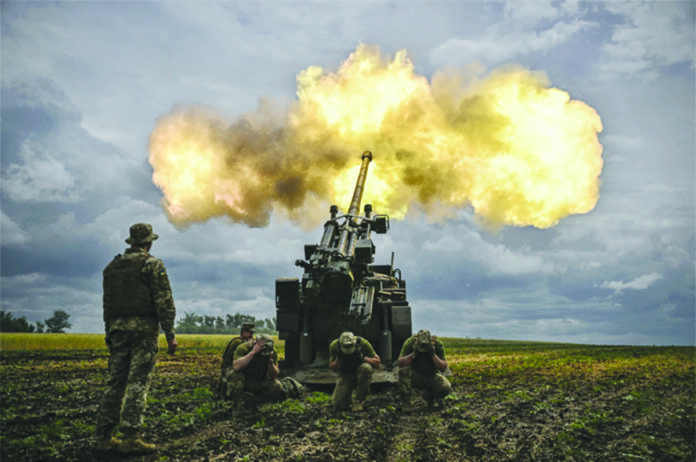Europe is once again faced with the possibility of a significant land conflict involving NATO forces. The full-scale Russian invasion of Ukraine in February 2022 has served as a wake-up call in the capitals of Europe. Many believed that substantial ground troops and land movement capabilities, especially heavy armored formations, would not be a defining aspect of future combat before that time. Even when Russia invaded and took Crimea at the beginning of 2014 and later encouraged and supported separatist action in Eastern Ukraine. Some European militaries developed plans to rebuild forces for significant ground operations in 2014 after decades of decreasing their capabilities. The conflict made it more urgent to address the enablers of operational capabilities that are crucial to the success and continuation of military missions and operations.
At the NATO summit in Madrid in June 2022, allies adopted a new Strategic Concept. This not only designated Russia as “the most significant and direct threat to allies’ security,” but it also gave NATO the go-ahead to strengthen its posture of defense and deterrence. The New Force Model (NFM) of NATO is designed to offer a larger pool of highly prepared forces than was anticipated under the NATO Response Force (NRF). NATO’s European partners are now prioritizing the recapitalization of their field troops.
NATO is creating regional plans to better defend Europe. They are “geographically specific plans that describe how the Alliance will defend itself against the two threats described in NATO’s Strategic Concept and the NATO Military Strategy: Russia and terrorist groups,” according to NATO officials. These plans “blend National Defense plans of our front line nations into NATO plans, and this optimizes NATO’s ability to move forces to the right place at the right time,” said Gen Christopher Cavoli, Supreme Allied Commander Europe. According to the regional plans, the Alliance must generate additional troops with high readiness levels.
Additionally, NATO is establishing updated capability targets that outline the quantity, nature, and organization of the tools, formations, and units required to carry out NATO missions. These goals and intentions are probably going to be discussed at the Vilnius Summit, which is scheduled for July 11 and 12. The regional plans are therefore anticipated to influence NATO member states’ priorities for command and control (C2), preparedness, and defense investment. Additionally, it will be crucial for NATO to balance its existing forces in Northern and Eastern Europe with locally sent reinforcements. NATO’s intentions for new joint regional command headquarters (HQs), multi-level land component command HQs, and theatre reserve or strategic reserve ground formations are all unknown at this time.
Some states had a specific focus on preparation immediately after 2014 and expressed concern about a potential reduction in force size. Latvia reported an increase in National Guard unit preparedness in 2014, and Lithuania announced an increase in Rapid Reaction Force readiness. Higher readiness was recommended in Finland’s 2017 Government’s Defense Report in light of a deteriorating security situation. In November 2022, Norwegian defence officials raised military readiness, and the Netherlands’ 2022 Defense White Paper promoted higher-readiness formations.
To make sure that NATO forces are ready and equipped to address present and future threats, it is crucial to improve their capacity to quickly raise their readiness, enablement, and combat capability. Europe requires prepositioned war reserve stockpiles, a strong and resilient fuel supply, operational readiness of fuels, and dependable infrastructure to assist Ukraine win the fight now and get ready to win the next war.
The European land forces under consideration have acknowledged weaknesses in their forces, which exist in all of them to varying degrees. These weaknesses include operational overstretch, a lack of stocks and resupply limitations, limited unit and formation level collective training, low personnel numbers, outdated equipment, inappropriate equipment, maintenance issues, and limited budgets. However, there is also a renewed focus on modernizing main battle tanks (MBTs) and tracked infantry fighting vehicles (IFVs), including in some West European states that transferred modern armour to Ukraine. This is due in part to the flow of Soviet-era armour to Ukraine by states in Eastern Europe.
Before or after the Vilnius Summit in July 2023, NATO nations should make their contributions to the NFM (New Force Model) explicit and disclose their land contributions. By doing this and holding governments accountable, they can enhance planning, increase the ability to deter Russia and boost ally unity. The Vilnius meeting gives the alliance’s top officials the chance to work together on a strategy to pinpoint problems and address burden-sharing in logistics. The collective resilience of Europe would be strengthened by a comprehensive strategy that included a NATO Resilience Planning Process and sufficient investments.
To make sure that NATO forces are ready and equipped to address present and future threats, it is crucial to improve their capacity to quickly raise their readiness, enablement, and combat capability. Europe requires prepositioned war reserve stockpiles, a strong and resilient fuel supply, operational readiness of fuels, and dependable infrastructure to assist Ukraine win the fight now and get ready to win the next war.























